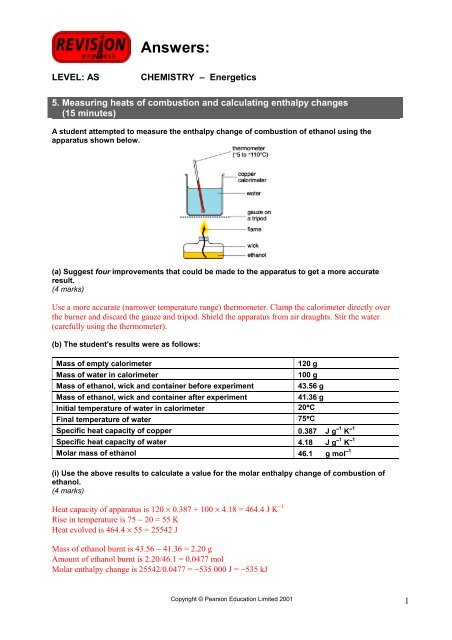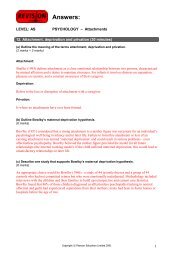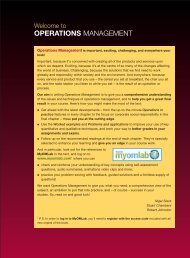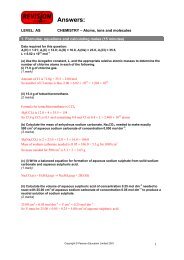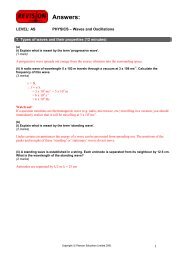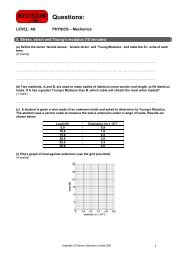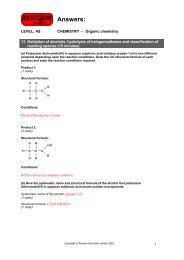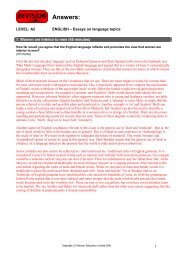5. Measuring heats of combustion and calculating ... - Pearson
5. Measuring heats of combustion and calculating ... - Pearson
5. Measuring heats of combustion and calculating ... - Pearson
Create successful ePaper yourself
Turn your PDF publications into a flip-book with our unique Google optimized e-Paper software.
Answers:LEVEL: ASCHEMISTRY – Energetics<strong>5.</strong> <strong>Measuring</strong> <strong>heats</strong> <strong>of</strong> <strong>combustion</strong> <strong>and</strong> <strong>calculating</strong> enthalpy changes(15 minutes)A student attempted to measure the enthalpy change <strong>of</strong> <strong>combustion</strong> <strong>of</strong> ethanol using theapparatus shown below.(a) Suggest four improvements that could be made to the apparatus to get a more accurateresult.(4 marks)Use a more accurate (narrower temperature range) thermometer. Clamp the calorimeter directly overthe burner <strong>and</strong> discard the gauze <strong>and</strong> tripod. Shield the apparatus from air draughts. Stir the water(carefully using the thermometer).(b) The student's results were as follows:Mass <strong>of</strong> empty calorimeter120 gMass <strong>of</strong> water in calorimeter100 gMass <strong>of</strong> ethanol, wick <strong>and</strong> container before experiment43.56 gMass <strong>of</strong> ethanol, wick <strong>and</strong> container after experiment41.36 gInitial temperature <strong>of</strong> water in calorimeter 20°CFinal temperature <strong>of</strong> water 75°CSpecific heat capacity <strong>of</strong> copper 0.387 J g −1 K −1Specific heat capacity <strong>of</strong> water 4.18 J g −1 K −1Molar mass <strong>of</strong> ethanol 46.1 g mol −1(i) Use the above results to calculate a value for the molar enthalpy change <strong>of</strong> <strong>combustion</strong> <strong>of</strong>ethanol.(4 marks)Heat capacity <strong>of</strong> apparatus is 120 × 0.387 + 100 × 4.18 = 464.4 J K −1Rise in temperature is 75 − 20 = 55 KHeat evolved is 464.4 × 55 = 25542 JMass <strong>of</strong> ethanol burnt is 43.56 − 41.36 = 2.20 gAmount <strong>of</strong> ethanol burnt is 2.20/46.1 = 0.0477 molMolar enthalpy change is 25542/0.0477 = −535 000 J = −535 kJCopyright © <strong>Pearson</strong> Education Limited 20011
Answers:LEVEL: ASCHEMISTRY – Energetics(ii) The data book value for the st<strong>and</strong>ard molar enthalpy change <strong>of</strong> <strong>combustion</strong> <strong>of</strong> ethanol is–1367 kJ mol –1 . Suggest reasons why the value calculated from the student's results differsfrom the value in the data book.(4 marks)The student's value shows not enough heat has been transferred to the caloimeter <strong>and</strong> its contentspossibly because heat was lost to the gauze, tripod <strong>and</strong> surrounding air, <strong>combustion</strong> was incomplete,some ethanol was lost by evaporation, the reactants <strong>and</strong> products were not measured under st<strong>and</strong>ardtemperature <strong>and</strong> pressure conditions.(c) Explain why a bomb calorimeter is used for accurate determinations <strong>of</strong> enthalpy changes<strong>and</strong> why the heat change measured is not an enthalpy change.(3 marks)Complete <strong>combustion</strong> occurs when the sample is burnt in pure oxygen under high pressure but thereaction takes place at constant volume, so the heat change measured is an internal energy change, ∆U.(Total 15 marks)Copyright © <strong>Pearson</strong> Education Limited 20012


